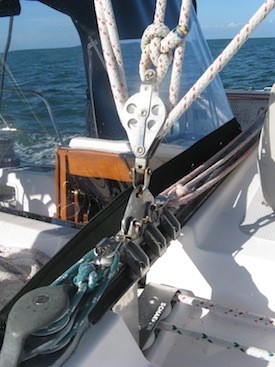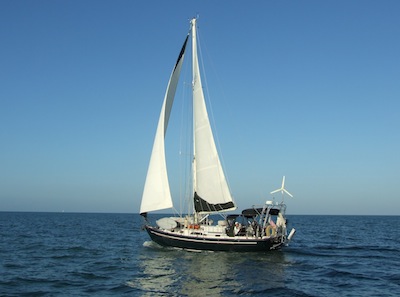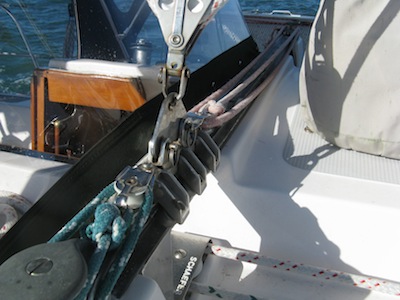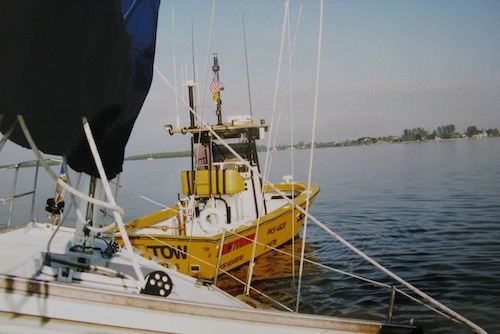Do you use the traveler aboard your boat? Most cruisers seem to leave the traveler cleated in the center of the boat and never move it. A few even claim that it’s main reason for being is to hang a cold beer for transport from one side of the cockpit to the other – in jest… I hope…
Because cruising boats are heavy and you may not “feel” response to changes, it’s easier for me to explain how we use the traveler in terms of racing our 18′ one design scow, Y Flyer (that’s our “off season” and one of the reasons we’re commuter cruisers).

Dinghy racing, at least in the Midwest requires constant use of the traveler. Upwind, it is our first line of defense against errant puffs that tend to heel the boat up and not increase forward speed, slowing us while racing… not good! One of my jobs as crew is to watch for errant puffs — when one’s coming, I let the traveler out a bit to spill the extra air, we hike hard and drive through the puff at the same heel angle as we were sailing before the puff. This allows us to harness the puff’s extra energy rather than waste it by merely heeling up the boat and showing our centerboard to competitors in the vicinity. This is an ongoing process – and not just in heavy air. David rarely dumps the main to keep the boat on track, instead we rely on the traveler. (Note: we have other settings we rely on while racing in these conditions, but they aren’t the subject of this post!)
Upwind in heavier air, we’ll often set the traveler a bit below center — maybe 2 inches (this is on an 18′ scow racing dinghy) and then “play” it from there, lowering it more in the puffs and bringing it back when the wind evens out. This keeps the boat on an even heel, not rounding up and not “sinking” into the water. Keeping the traveler a bit lower than center gets rid of the boat’s tendency to round up in stronger winds — i.e. turn into the wind — which is caused by “weather helm” on the rudder — more pressure on one side of the rudder than the other creating drag with the extra water friction.
In light air, the traveler is our friend as well – pulling the traveler higher on the track, or “to weather” allows us to sail closer to the wind and point higher than other boats.
Summarizing, the function of the traveler is to add twist to the mainsail or flatten it depending on whether you’re using it to pull to weather or drop to leeward. Adding twist or flattening counteracts weather helm which creates extra drag on the rudder and slows the boat. It also allows the boat to stay on an “even heel”.
Leaving the race course now and applying the practical information to a cruising sailboat …
1. If your boat is heeled more than is comfortable (or than the admiral prefers), try dropping the traveler down to leeward and see what effect it has on the boat’s heel. (Reducing sail and other sail adjustments will help this as well, but the subject of this post is the traveler and we often drop the traveler and reduce sail area.)
2. In general in heavier air, we drop the traveler to leeward as well as reef the main to keep the boat under control. This is one of the two most important uses for the traveler while cruising. Note that the windier or puffier it is, the further down we drop the traveler.
3. Upwind, if you have drag on the rudder (weather helm) — the wheel may be turned a quarter turn to the right. You’re counteracting the water pressure on the rudder which is trying to turn the boat up into the wind in order to keep the boat on course. Try dropping the traveler by a few inches to leeward — experiment to see if you can get it until the weather helm is gone and the helm is neutral.
3. If you’re motorsailing and having a hard time keeping the main from flogging — before you decide to drop it entirely, try pulling the traveler up to windward which will allow you to motor closer to the wind. Basically what you’ve done is moved the apparent wind farther in front of you.
Happy travelering! Anyone use their traveler for more or differently? Please leave a comment and share! THANKS! Jan















Every time I have a question. You guys seem to have an answer. It just magically pops up!! How did you know.
Jan,
Maybe it’s not the same in some boats, but your advice has another step, and that’s to use the traveler to reduce heel while maintaining boat speed/power in heavy winds (prior to reefing!) by moving the traveler WELL to windward and easing the main sheet, allowing the head of the sail to nearly luff, while the foot stays close-hauled.
Might sound counter-intuitive, but try it! With the boom well to windward and the sheet eased, the lower part of the sail is flying at a close-hauled angle to the apparent wind, while the head – where most of the heeling force develops – is spilling most of it’s wind.
In many boats (the J-35 and my Tanzer 7.5 are two I have personal experience with) the result is to put the boat back on her feet, make the admiral happy, and reduce weather helm to normal levels, and frequently boat speed INCREASES because teh boat is on her feet where she’s happiest.
Hi Keith! My “Technical Editor” … that would be David has heard that too. He’s very curious to try it & see if it works on our Passport 37 this winter. It seems logical, but Winterlude doesn’t heel much anyway with our cutaway full keel and weight, so we shall see! Hopefully I’ll remember to post a follow-up comment here & let you know! THANKS for the tip, we’re always looking for better ways to do everything! 🙂 Cheers – Jan
As someone who graduated from a Sunfish to a 26′ keelboat, I had my traveller cleated in place. Thanks to this article, I now understand what the thing is for. Along with performance, this should help keep Jill from getting too nervous while not sacrificing performance.
Hi Debra! If you have specific questions, e-mail me or Facebook message me & I’ll see if we can answer them… if not, I’ll let you know. 🙂 THANKS! Jan
I travelled in my sailboat
I used my traveller recently as a give way vessel we were approaching didn’t give way, while I was on a very close haul. In was crossing in front of us, in such a way that to avoid I would have had to head up into the wind, however that would have put me in irons.
The alternative would have been to completely tack the boat, which would have put us on wrong course as we approached the harbor mouth.
What I did instead is pulled the traveller somewhat far on the windward side, and steered the boat pretty much right into the winds. The windward traveller gave our sails enough of an angle on the wind to avoid the collision without needing to tack or ending up in irons.